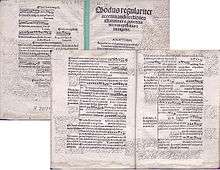Sebastian z Felsztyna
Sebastian z Felsztyna (also Sebastian de Felstin, Sebastian Herburt) (c. 1480/1490? – after 1543) was a Polish composer and music theorist, regarded as the greatest Polish composer of the early 16th century.[1]

Life
He was probably born in Felsztyn, in present-day Ukraine on the border with Poland. In 1507 he entered Kraków University, the same year as his compatriot, composer Mikołaj z Chrzanowa. While there he studied music and theology, receiving his baccalaureate in 1509. He may have studied with Heinrich Finck while in Kraków.[2] After graduating, he returned to Felsztyn where he became a chaplain, and later he went to Sanok, also in southeastern Poland, where he was a provost.[3]
Musical works and theoretical writings
Of his musical works, only three motets survive. They are for four voices, and use a plainchant tenor in long notes – an archaic practice at the time of publication, 1522 – with the other voices sometimes engaging in imitation, in free counterpoint, or in more homophonic textures. All three are preserved in Wawel Cathedral in manuscript. While archaic in style, they show the influence of the Franco-Flemish school, and are a rare early example of four-voice polyphony in Poland.[3] Indeed, Reese acknowledges Felstin's assimilation of Franco-Burgundian influences.
Sebastian published a collection of his hymns in 1522 in Kraków, Aliquot hymni ecclesiastici, but no copies survive.[2]
Sebastian's theoretical treatises cover the topics of notation and chant.[2] His most popular was Opusculum musices of 1519, which was twice reprinted, and most likely was intended as an instructional tool for singers.[3]
Works
Writings on music
Motets
- Ave Maria ("Alleluia ad Rorate cum prosa Ave Maria"), four voices
- Alleluia, Felix es sacra virgo Maria, four voices
- Prosa ad Rorate tempore paschali virgini Mariae laudes, four voices
These three motets, according to Reese (1959, p. 747) all feature Gregorian melodies in the tenor in whole notes.
Notes
- Reiss, Józef Władysław (1984). Najpiękniejsza ze wszystkich jest muzyka polska: szkic historycznego rozwoju na tle przeobrażeń społecznych. Polskie Wydawnictwo Muzyczne. p. 50. ISBN 978-83-224-0243-6.
- Elżbieta Witkowska-Zaremba. "Sebastian z Felsztyna." In Grove Music Online. Oxford Music Online, http://www.oxfordmusiconline.com/subscriber/article/grove/music/25287 (accessed December 16, 2011).
- Reese, Gustave (1959). Music in the Renaissance. W.W. Norton & Co. pp. 746–7. ISBN 0-393-09530-4.
References
- Stępień B., Sebastian z Felsztyna, "Kamerton", 2005 Nr 1-2 (48-49), s. 242-245. ISSN 1233-8249.
- Mała encyklopedia muzyki (A Little Encyclopedia of Music), Warszawa 1981